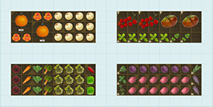Basics
- Ease of Growing
- Easy
- Grown as
- Perennial
- Growing Habit
- -
- Hardiness
- Hardy
Strawberries are hardy during the Winter and can withstand frost. It is important to plant your berries in a place that is sheltered from Spring frosts, as strawberries become very tender once they blossom.
- Crops
- Spring Transplant, Fall Transplant
- Growing Season
- Short, Long
- Cultivar Type
- Early
- Growing Conditions
- Cold, Cool, Warm, Hot
Strawberries love sunshine. They will tolerate moderate shade, but they produce significantly better when they are planted in an area that receives full daytime sun. Plants will tolerate frost, but should be protected before.
- Outdoor Growing Temp
- 60°F - 90°F
- Min Outdoor Soil Temp
- 60°F
Plant strawberries as early as you can so you can get growth going. You'll have to wait until the soil is at least 60F.
- Start Indoors
- No
- Start Outdoors
- No
- Light
- Sun: min. 6 hours daily (Cool, Warm, Hot)
Strawberries must have full sun (at least 6 hours daily) for maximum productivity and best flavor. They will tolerate some shade, but productivity will suffer.
Part shade (Warm, Hot)In hot climates, strawberries will benefit from afternoon shade.
- Water
- Moderate
Strawberries must have a steady supply of water at all times, but especially during flowering and fruiting. Water is also very important in fall when next year's flower buds are developing. If they are dry at this time it can affect the following year's crop.
The plants should receive at least 1" of water per week, though of course the exact quantity needed will depend upon the growing conditions. Drip irrigation works best as it keeps leaves and fruit dry, which reduces the potential for serious fungus and disease problems.
- Feeder
- Heavy
Strawberries are fairly hungry plants and should be given plenty of nutrients (especially phosphorus and potassium) for maximum fruit production.
- Suitability
- Tolerates light frost, Tolerates hard frost, Partial shade, Needs summer shade
- Small Gardens?
- Yes
- Containers?
- Yes
Strawberries are an excellent candidate for container growing, and will thrive in almost any size container so long as it drains well. Fill the container with a good, loamy potting mix and add fertilizer as necessary. Plant the strawberries so that the root is fully covered and the crown is just above the soil line.
- Attracts beneficial insects?
- Yes
- Color
- Red
- Fruit Size
- 1.0 - 2.0"
- Plant Height
- 6.0 - 8.0"
- Plant Diameter
- 10.0 - 12.0"
- Good Companions
- Lettuce, Nasturtium, Onion, Radish, Spinach, Borage
- Bad Companions
- Cabbage, Potato
- Hardiness Zone
- 4-10
- Disease Resistance
- -
- Taste Profile
Dark red, sweet fruit.
- Rotation Group
- Perennial

